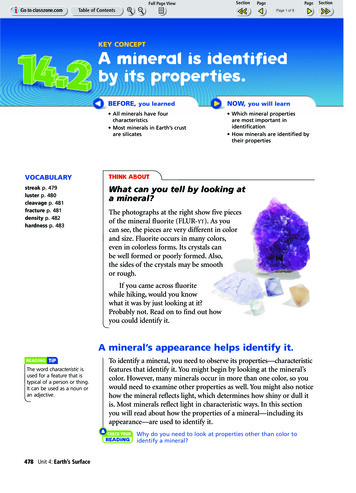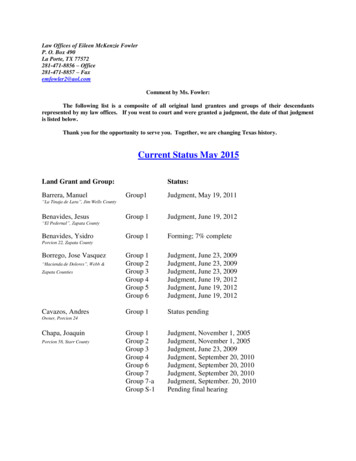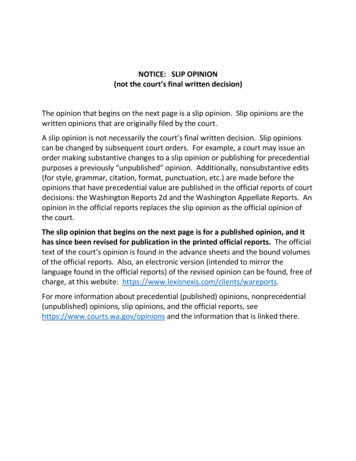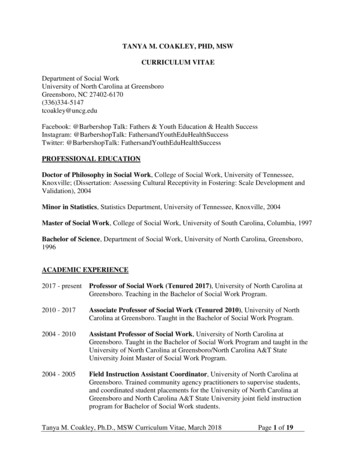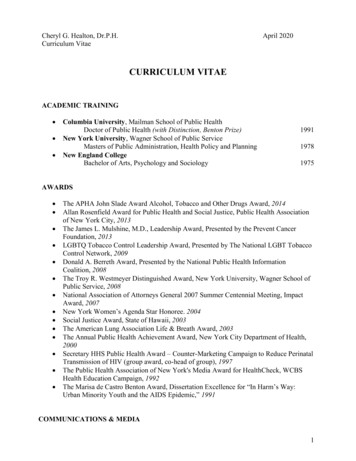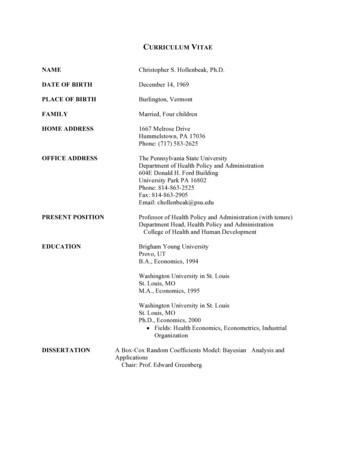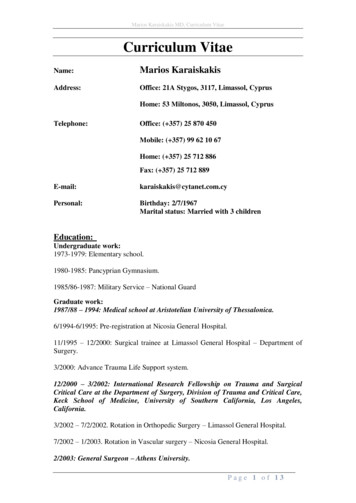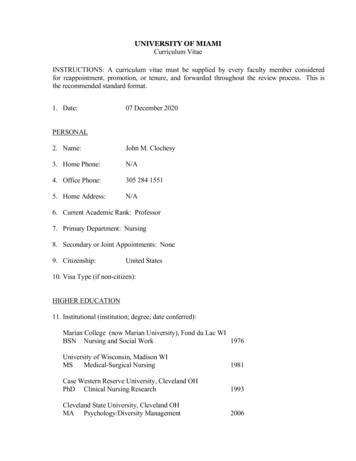
Transcription
CURRICULUM VITAELuster FowlerEDUCATIONIndiana State University, Doctor of Philosophy, Educational Leadership, 2013Indiana Wesleyan University, Master of Business Administration, 2003Indiana Wesleyan University, Bachelor of Science, Business Administration, 1999CERTIFICATIONSNational Board for Respiratory Care: Registered Respiratory TherapistAmerican Heart Association Certification: Advanced Cardiac Life SupportAmerican Heart Association Certification: Pediatric Advanced Life SupportAmerican Heart Association Certification: Basic Life SupportPROFESSIONAL AFFILIATIONSAmerican Association for Respiratory CareIndiana Society for Respiratory CareAssociation for the Study of Higher EducationNational Network of Health Career Programs in Two Year CollegesCity of Lawrence-Pioneering Healthy Communities Advisory BoardIndiana University Health-Allied Health Education Advisory BoardMetropolitan Indianapolis Central Indiana Area Health Education Committee-Advisory BoardChairMcKenzie Career Center for Health Occupations-Advisory Board
HIGH-FIDELITY MANIKIN-BASED SIMULATION: A STUDY OF IMPLICATIONS FORINTERPROFESSIONAL HEALTHCARE PRACTITIONER EDUCATION AT THEASSOCIATE DEGREE LEVEL OF STUDYA DissertationPresented toThe College of Graduate and Professional StudiesDepartment of Educational LeadershipIndiana State UniversityTerre Haute, IndianaIn Partial Fulfillmentof the Requirements for the DegreeDoctorate of PhilosophyByLuster FowlerMay 2013 Luster Fowler 2013Keywords: healthcare education, simulation, interdisciplinary, nursing, manikin
iiCOMMITTEE MEMBERSCommittee Chair: Will Barratt, Ph.D.Professor: Educational LeadershipIndiana State UniversityCommittee Member: Joshua Powers, Ph.D.Professor: Educational LeadershipIndiana State UniversityCommittee Member: Betsy Frank, RN, Ph.D., ANEFProfessor Emeritus: College of Nursing, Health, and Human ServicesIndiana State University
iiiABSTRACTHealthcare practitioner training programs, specifically at the associate degree level of study, havehistorically focused practitioner training efforts on discipline-specific programming andcurricula. However, these institutions have now begun to examine the utility and efficacy ofincorporating interprofessional experiences into their programs. One of the current pedagogicalapproaches being investigated is the use of high-fidelity manikin-based simulation in the trainingof their healthcare students. This study examined the use of interprofessional high-fidelityversus low-fidelity simulation within associate degree-granting institutions and examinedpotential differences in self-efficacy and learning outcomes of participants incorporating a preand post-assessment.A convenience sample of 75 students participated in this study, which included associatedegree-seeking nursing students (n 36) and associate degree-seeking respiratory care students(n 39). Participants were divided into two groups: a high-fidelity group (n 52) and a lowfidelity group (n 23). Each group was composed of both nursing and respiratory care students.A subsequent assessment of pre-intervention and post-intervention self-efficacy and learningoutcomes was also performed that examined students by course of study, identified as eithernursing students or respiratory care students.Differences in self-efficacy between the high-and low-fidelity groups were not significanton pre-assessment or post-assessment, p .529 and p .246. Additionally, differences between
ivnursing and respiratory care students were not significant on pre-assessment or post- assessment,p .079 and p .779 respectively.Differences in perceived learning outcomes between the high-and low-fidelity groupswere not significant on pre-assessment or post-assessment, p .747 and p .219. Additionally,differences between nursing and respiratory care students were not significant on pre or postassessment, p .408 and p .611 respectively.
vACKNOWLEDGEMENTSI would like to extend my appreciation and heartfelt thanks to many individuals whoaided me greatly throughout this quest. First, I would like to thank my committee chair, Dr. WillBarratt, who provided sound guidance and feedback to me throughout this journey. Secondly, Iwould like to thank my other committee members, Dr. Joshua Powers and Dr. Betsy Frank.Certainly I would not have been able to successfully complete this journey without theirpatience, direction, and continued support. I would also like to thank two additional facultymembers of the Indiana State University Educational Leadership doctoral program who wereinstrumental to my success. These two faculty members provided me with direction that wasessential to my success and my ultimate completion of this program. Those faculty members areDr. Kandace Hinton and Dr. Mary Howard-Hamilton. Lastly, I would be remiss if I did notthank my colleagues from Doctoral Cohort 12 of Indiana State University’s EducationalLeadership program. I wish to thank them for their kinship, collaboration, and support throughthe coursework and residency requirements of this program. These colleagues are ChannellBarbour, Robert Dean Branson, Kimberly Clemens, Nancy Crone, LaKesha Denton, SamDeWeese, Corey Guyton, Evangelos Kontaxakis, Joshua Lawrie, Kate Lehman, RebeccaMerton, Allison Rynerson, and Michael Wetherholt.
viTABLE OF CONTENTSCOMMITTEE MEMBERS . iiABSTRACT . iiiACKNOWLEDGEMENTS .vLIST OF TABLES .xLIST OF FIGURES . xiiINTRODUCTION .1History of Manikin-Based Patient Simulators . 1Statement of the Problem . 8Purpose of the Study . 9Research Questions . 11Significance of the Study . 12Definition of Terms . 14High-Fidelity Simulation . 14Interprofessional Education . 14Low-Fidelity Simulation . 14Self-Efficacy . 14REVIEW OF THE LITERATURE .15Low-Fidelity Manikin-Based Simulation . 16High-Fidelity Manikin-Based Simulation . 19
viiSimulation Use in Physician Education . 21Simulation Use in Nursing Education . 23Simulation Use in Respiratory Therapy Education . 26Simulation in Collaborative Interprofessional Education (Low-and High-Fidelity) . 30Benefits of Interprofessional High-Fidelity Simulation . 34Enhancement of the Ability to Assess Student Competency and Self-Efficacy. 36Self-Efficacy . 37Enhancement of Student Learning Outcomes . 39Enhancement of Student Ability to Apply Theory to Practice . 40Enhancement of Patient Safety . 41Enhancement of the Interprofessional Educational Experience . 43Summary . 44METHODOLOGY .46Research Questions . 46Design of Study . 47Experimental Group Setting . 49Control Group Setting . 50Population and Sample . 51Group Descriptions . 52Experimental Group . 52Control Group . 53Recruitment . 54Instrumentation . 55
viiiDemographic Survey Form . 55Interprofessional Self-Efficacy Assessment (ISEA) . 55Learning Outcomes Assessment Scale . 56Analysis . 56Summary . 57PRESENTATION OF THE DATA .59Population and Sample . 59Descriptive Data . 61Age .61Gender 62Ethnicity . 63Participant GPA . 64Parental Educational Level . 64Previous Healthcare Experience 66Previous High-Fidelity Experience . 67Major Findings . 69Research Question 1 . 69Research Question 2 . 73Ancillary Findings . 77Analysis of Means by Participant Type .78Analysis of Means by Student Type .79Summary of the Findings . 81CONCLUSION AND RECOMMENDATIONS .83
ixPurpose. 83Methods . 84Research Question 1 . 85Research Question 2 . 85Limitations . 86Total Sample Size of Participants . 86Differences in the Educational Level of Participants at the Point of Participation. 86Measure of Knowledge . 88Implications and Recommendations . 89Implications. 89Recommendations . 91REFERENCES .94APPENDIX A .104APPENDIX B .105APPENDIX C .108APPENDIX D .110APPENDIX E .112APPENDIX F.113APPENDIX G .115APPENDIX H .116
xLIST OF TABLESTable 1. Participant Age .62Table 2. Participant Gender .62Table 3. Participant Ethnicity .63Table 4. Participant GPA .64Table 5. Participant Parental Education Level .66Table 6. Participant Previous Healthcare Experience .67Table 7. Participant Previous High-Fidelity Experience .69Table 8. ANCOVA Summary of Pre-Treatment Self-Efficacy by Participant Type .70Table 9. ANCOVA Summary of Post-Treatment Self-Efficacy by Participant Type.71Table 10. ANCOVA Summary of Pre-Treatment Self-Efficacy by Student Type .72Table 11. ANCOVA Summary of Post-Treatment Self-Efficacy by Student Type .73Table 12. ANCOVA Summary of Pre Treatment Learning Outcomes by Participant Type .74Table 13. ANCOVA Summary of Post-Treatment Learning Outcomes by Participant Type .75Table 14. ANCOVA Summary of Pre-Treatment Learning Outcomes by Student Type .76Table 15. ANCOVA Summary of Post-Treatment Learning Outcomes by Student Type.77Table 16. Comparison of Pre-and Post-Treatment Means of Self-Efficacy by Participant Type.78
xiTable 17. Comparison of Pre-and Post-Treatment Means of Learning Outcomes by ParticipantType .79Table 18. Comparison of Pre and Post-Treatment Means of Self-Efficacy by Student Type .80Table 19. Comparison of Pre-and Post-Treatment Means of Learning Outcomes by StudentType . . 81
xiiLIST OF FIGURESFigure 1. A representation of the study design designating groups, interventions,and measures . .48
1CHAPTER 1INTRODUCTIONThe use of technology has always been viewed as a positive innovation and widelyaccepted as a requirement for institutions providing healthcare as well as for institutionsproviding healthcare education. From the development of the polio vaccine by Dr. Jonas Salk,with initial testing in 1952, to the use of interactive high-fidelity manikin-based patientsimulators in the educational setting, the profession of healthcare considers the practice ofmaintaining currency on technological changes in the practice of healthcare paramount to theprovision of the best patient care possible. The use of high-fidelity manikin-based patientsimulation in the higher education setting has been embraced by physicians and nursing in thehealthcare educational setting. However, the need for additional study is warranted in order todetermine the benefits of high-fidelity simulator use in interprofessional education from abroader perspective that considers other allied health professions within two-year institutions atthe associate degree level of study.History of Manikin-Based Patient SimulatorsThe healthcare providers in hospital settings have experienced an evolution in technologyover the course of recent history. As this technology continues to evolve in the hospital setting,institutions of higher education must also stay abreast of such changes in order to provideappropriate and timely education for students engaged in active pursuit of future healthcarecareers. One of the many modern technologies utilized by many higher education institutions is
2the high-fidelity manikin-based human patient simulator. However, the incorporation of highfidelity simulation in healthcare education and its potential effects on the education of healthcarepractitioners is a fairly recent phenomenon.Simulation, as a practitioner-based educational tool in health care, is derived from thefield of aviation. In 1929 Edwin Link developed the first aircraft simulator to assist studentpilots with training and subsequently added analog computer feedback mechanisms in order toprovide student pilots with additional useful information related to aircraft operation (Rodgers,2007). An added benefit acquired over the evolution of simulation in the aviation industry hasbeen the provision of an alternative avenue for student and certified pilots to practice hands-onskills and critical thinking via realistic flight simulators in a controlled environment, without thepotential danger of a crash. Healthcare is now catching up to the use of high-fidelity simulationtechniques and recognizing that medical errors in either educational or healthcare environmentsare unacceptable, just as aviation realized that plane crashes were unacceptable many years ago(Holtschneider, 2007).The use of manikin-based simulation began its journey from low-fidelity to high-fidelityin the early 1960s with Peter Safar, an Austrian physician, and Asmund Laerdal, a toymanufacturer. Safar and Laerdal developed Resusci -Anne, which was the first manikin usedfor the training of students in cardiopulmonary resuscitation (CPR); (Fritz, Gray, & Flanagan,2008). Laerdal was encouraged to assist with the design by Dr. Bjorn Lind and other Norwegiananesthesiologists, following Dr. Safar’s revelations regarding the discovery of increasedefficiencies regarding the methodologies used to perform mouth-to-mouth resuscitation (Safar,1958; Safar, Escarraga & Elam, 1958). These discovered efficiencies provided an avenue topotentially increase patient outcomes related to the performance of CPR by preventing the
3airway from becoming obstructed by hyperextending the neck during CPR as well as providingan opportunity to simulate the performance of cardiac compressions performed during CPR bythe insertion of an internal spring to the chest wall of the Resusci -Anne manikin (Cooper &Taqueti, 2004). Previous to the introduction of Resusci -Anne, a void existed for healthcareinstitutions and emergency personnel to have an avenue available to practice and become moreeffective practitioners of CPR, other than during actual patient emergencies.Additional developments along the evolutionary path of manikin use in healthcareeducation occurred in the year 1967 with the conception and development of the SIM ONEmanikin by Dr. Stephen Abrahamson, an engineer, and Dr. Judson Densen, a physician, at theUniversity of Southern California (Cooper & Taqueti, 2004; Fritz et al., 2008). This very basiclow-fidelity patient simulator, which provides the foundational tools for experiential-basedlearning for the student without the components of actual interaction and feedback provided byhigh-fidelity manikin-based patient simulators, was the first hands-on simulator created and wasalso used for the development of skills proficiency for anesthesiologists in a competency calledendotracheal intubation, as well as for the fields of radiology, surgery, and emergency andintensive care medicine (Tsai, Harasym, Nijssen-Jordan, Jennett & Powell, 2003). Dr.Abrahamson and Dr. Densen purported that the SIM ONE manikin provided several noteworthyadvantages to traditional clinical instruction methods, including (a) planned and gradualincreases in the problems to be solved instead of performing new tasks as the necessity arises inthe clinical care setting, (b) unlimited repetition, (c) immediate feedback, and (d) the provision ofthe option for learners to proceed at their own pace during the instructional process (Good,2003).
4The high-fidelity simulator was a remarkable lifelike mannequin that was controlled by ahybrid digital and analogue computer with 4096 words of memory. It had many high-fidelityfeatures: the chest was anatomically shaped and moved with breathing, the eyes blinked, thepupils dilated and constricted, and the jaw opened and closed. To a limited extent, it was usedfor training and to continue some primitive experiments about efficacy. Although not rigorouslyjustified by the methods, Dr. Abrahamson and Dr. Denson claimed that the simulator had atwofold advantage in training anesthesia residents in the skill of endotracheal intubation while“posing significantly less threat to patient safety” (Cooper & Taqueti, 2004, p. i12).The SIM ONE manikin served as a point of inception for the development of a computercontrolled manikin whole patient simulator. Unfortunately, during this time SIM ONE failed togain widespread acceptance as the computer technology was too expensive forcommercialization of the product (Fritz et al., 2008). Additional concerns related to thecommercialization of the product included the lack of vision pertaining to the market for traininghealthcare professionals in the product’s use as the SIM ONE manikin was too far ahead of itstime in terms of technology and any prospective market demand for its use in an instructionalsetting (Cooper & Taqueti, 2004).In 1987, Gaba and DeAnda developed the Comprehensive Anesthesia SimulationEnvironment 1.2 (CASE 1.2) manikin at the Stanford Medical School (Cooper & Taqueti, 2004).The CASE 1.2 manikin was developed as the first prototype simulator specifically developed forthe purpose of investigating human performance in anesthesia. The CASE 1.2 modelincorporated a commercially available waveform generator and virtual instrumentation with themanikin to simulate a patient whose vital signs could be manipulated to simulate critical events.This model served as the inception point of a high-realism simulation environment (Cooper &
5Taqueti, 2004). Subsequent versions of the CASE manikin simulator were developed andutilized for the purposes of enhancing the educational realism of simulation at the StanfordMedical School and ultimately resulted in the development and implementation of a curriculumentitled Anesthesia Crisis Resource Management (Good, 2003), which was based on a relativelynew aviation model of crew resource management (Cooper & Taqueti, 2004). In later years, thecompany licensed the CASE 1.2 and subsequent CASE 2.0 simulation products to a companycalled CAE-Link and eventually the company was acquired by a company called Med Sim Ltd,which eventually halted production of the product, primarily due to an unsuccessful marketingstrategy (Fritz et al., 2008).During the approximate period of manufacturing of the Med Sim manikin, anothersimulator was being developed at the University of Florida called the Gainesville AnesthesiaSimulator (GAS), (Good & Gravenstein, 1989). Interest in the development of this particularsimulator arose from a clinical need to train anesthesiology resident physicians in basic clinicalskills, which were perceived to be in need of supplementation at the time. A secondary purposefor the development of the GAS simulator was to provide a secondary mechanism for senioranesthesia resident physicians to practice detecting and correcting rare and complex failureswithin the anesthesia gas delivery equipment (Good & Gravenstein, 1989). Themultidisciplinary team developing the GAS simulator was led by Good and mentored byGravenstein and began with the development of a single capability of diagnosing faults inanesthesia machines in which controllable failure modes were embedded and subsequentlydeveloped into a complete manikin which could mimic the uptake and distribution of gases usedin anesthesia (Cooper & Taqueti, 2004). Later versions of the GAS simulator incorporated amechanism for automatically recognizing as it was injected as well as providing the capability to
6enact simulated physiological changes occurring in humans as both predefined sequences or inresponse to actions initiated by the trainer and trainee on the simulator (Cooper & Taqueti,2004).The development of the GAS simulator continued to progress when two very smallstudies conducted by Good, Gravenstein, and Mahala (1992) tested the efficacy of the GASsimulator. Researchers in this study randomized two cohorts of anesthesia residents who werestratified by whether or not simulation instruction was received and was followed by clinicalevaluations of the residents’ performances. The clinical evaluators were blinded as to the testparticipants’ cohort status in order to provide objectivity. The results of this very small study (n 16) indicated a more rapid learning curve for the participants in the cohort receiving simulationinstruction prior to clinical evaluation. However, this study was ended after a three-monthperiod in order to satisfy the increased demand for additional simulation training for all residentphysicians (Good et al., 1992). In later years the GAS simulator was licensed to Loral DataSystems, which was later acquired by Medical Education Technologies Inc., which developedthe product for commercial use and dubbed their new flagship product the Medical EducationTechnologies, Inc. (METI) Human Patient Simulator (HPS).The HPS represented an evolution of development from its predecessor, the GAS.Subsequent models after the development of the HPS model included a pediatric manikin calledPedisim and a much simpler model called the ECS, which were both introduced in the late 1990sand early 2000s respectively (Cooper & Taqueti, 2004). The current adult HPS modelincorporates physiological and pharmacological modeling as the operating platform, which givethe simulator the ability to react like a live human by imitation of the appropriate humanresponse (Durham & Alden, 2008). The response to input stimuli is provided by integrated
7functions programmed into the HPS and displayed in a multi-layered, real time in a multilayered, real-time ways which are vital to a true-to-life medical learning experience (METI.,2004). Additional features of the company’s current product include the ability to providerespiratory gas exchange, anesthesia delivery, and patient monitoring with real physiologicalclinical monitors (METI., 2010).Subsequent to the development of the Resusci -Anne CPR simulator in the early 1960s,as well as the SIM ONE, CASE, and GAS simulator man
nursing and respiratory care students were not significant on pre-assessment or post- assessment, . the coursework and residency requirements of this program. These colleagues are Channell Barbour, Robert Dean Branson, Kimberly Clemens, Nancy Crone, LaKesha Denton, Sam DeWeese, Corey Guyton, Evangelos Kontaxakis, Joshua Lawrie, Kate Lehman .
